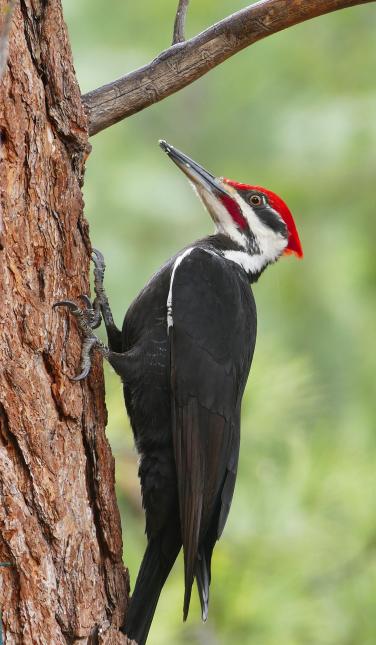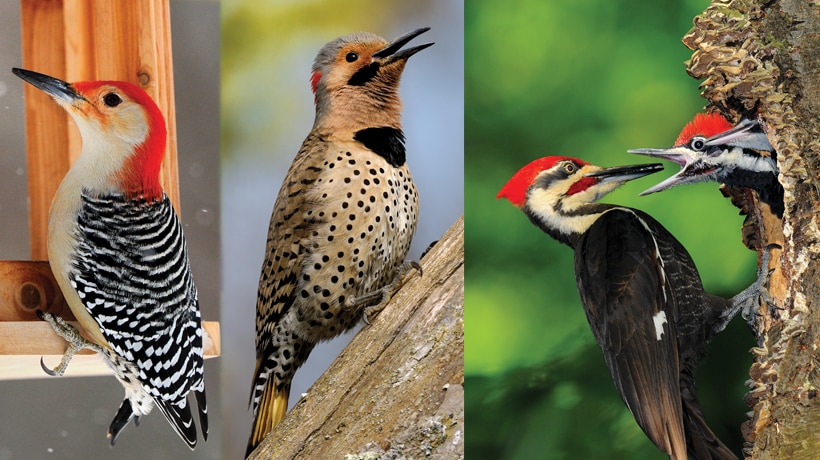Woodpeckers Unleashed: Checking Out the Marvels of These Proficient Tree Mountain Climbers
Woodpeckers, with their distinctive markings and rhythmic drumming resembling via wooded areas, hold an unique area in the bird globe. Their specialized composition and adjustments enable them to navigate vertical surfaces with exceptional ability. However, their mastery of tree climbing is just one facet of their fascinating behavior. As we explore the complex information of woodpeckers' nesting habits, feeding strategies, and the recurring preservation initiatives to protect these exceptional birds, a much deeper recognition for their location in nature unravels.
Composition and Adaptations
When checking out the anatomy and adjustments of woodpeckers, one can observe exceptional features that allow these birds to thrive in their specialized ecological particular niche. Additionally, woodpeckers have zygodactyl feet, with 2 toes facing forward and 2 dealing with backward, supplying a firm grip on tree trunks while they browse for food or drum for communication.
Additionally, woodpeckers have a distinct tongue framework that is long, barbed, and sticky, allowing them to remove bugs from crevices in timber. This specialized adjustment enables woodpeckers to manipulate a food source that is inaccessible to several various other bird species. On the whole, the anatomy and adaptations of woodpeckers display the exceptional transformative options that have actually allowed these birds to thrive in their arboreal habitat.
Drumming Actions
Having actually checked out the anatomy and adaptations of woodpeckers, the focus now changes to comprehending their drumming actions, an unique facet of their communication and territorial screens. Drumming is an important kind of communication amongst woodpeckers, serving several purposes such as establishing territories, attracting friends, and signaling alarm. Each woodpecker types has a distinct drumming pattern that aids individuals acknowledge members of their own species and differentiate them from rivals or predators.
Woodpeckers create drumming noises by rapidly pecking on resonant surface areas such as dead trees, energy poles, or perhaps steel things, developing a series of balanced beats. The intensity and rate of drumming can differ based upon the function; for circumstances, a fast drumming sequence might signify aggressiveness in the direction go to this site of burglars, while a slower and softer drumming pattern might suggest courtship (Woodpeckers in Florida). Additionally, woodpeckers might change the frequency and period of their drumming to share certain messages effectively
Nesting Behaviors
Exploring the nesting habits of woodpeckers reveals remarkable insights into their reproductive behaviors and habitat selections. Woodpeckers are understood for their special nesting preferences, frequently digging deep into tooth cavities in trees to create sheltered spaces for elevating their young. These dental caries serve not just as a nesting site image source however likewise as a safe and secure refuge from killers and inclement weather condition.
Woodpeckers exhibit a high level of fidelity to their nesting websites, usually returning to the same location year after year. This actions highlights the importance of ideal habitat accessibility for their reproductive success. The option of a nesting website is crucial for woodpeckers, with elements such as tree types, elevation, and degeneration stage playing significant roles in their decision-making process.
Remarkably, some woodpecker species are understood to dig deep into several tooth cavities within their region, offering themselves with alternate nesting choices. This strategy might act as a kind of insurance policy versus possible risks or disturbances to their primary nesting site.

Feeding Techniques
One of the most unique feeding this behaviors of woodpeckers is drumming, which involves quick pecking on trees to discover insects under the bark. Woodpeckers are likewise known to excavate tooth cavities in trees to gain access to covert insect larvae or sap. Some varieties, like the acorn woodpecker, shop nuts in specially created openings called granaries.
Conservation Efforts
In the middle of the elaborate feeding methods displayed by woodpeckers, the conservation efforts targeted at protecting these interesting birds play an essential duty in preserving their habitats and populaces. Woodpeckers encounter numerous risks to their survival, consisting of habitat loss as a result of deforestation, climate adjustment modifying their ecosystems, and collisions with manufactured structures such as structures and cars - Woodpeckers in Florida. Conservationists are proactively working to deal with these difficulties and ensure the long-lasting well-being of woodpecker types

Education and public understanding projects are also essential components of woodpecker preservation initiatives. By elevating understanding regarding the relevance of these birds in keeping healthy woodland environments, guardians can garner assistance for habitat preservation campaigns and advertise accountable land management methods. Via collective initiatives between scientists, policymakers, and regional areas, we can collaborate to secure a future where woodpeckers thrive in their all-natural habitats.
Verdict
